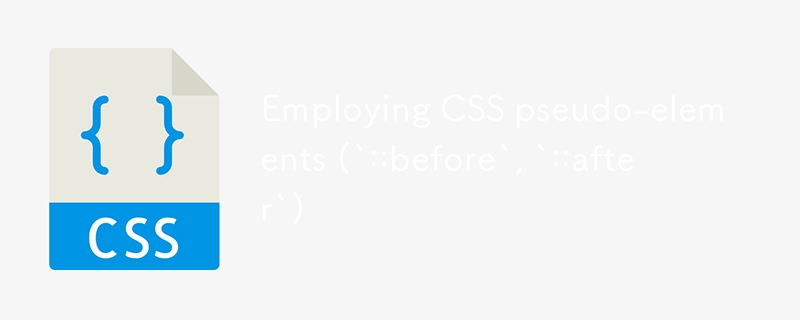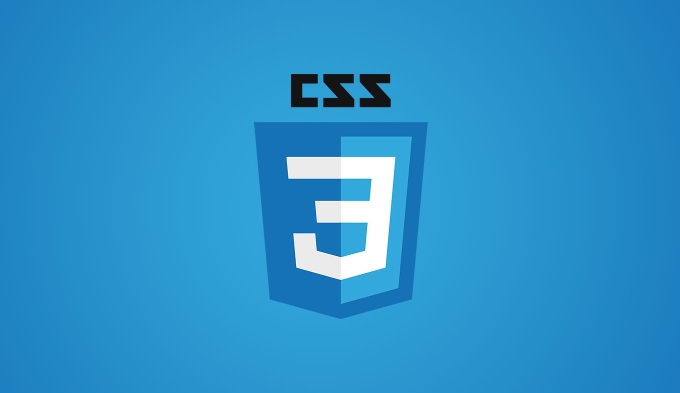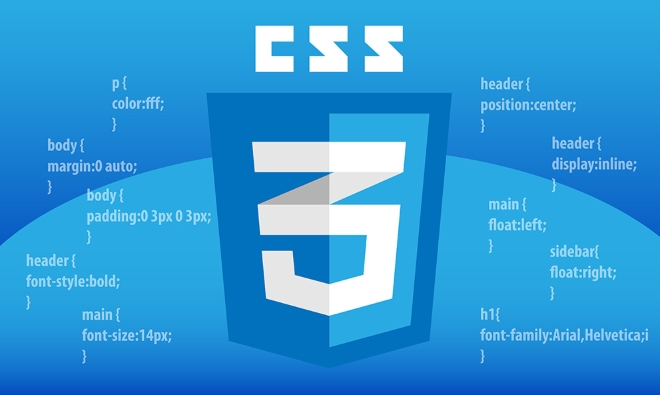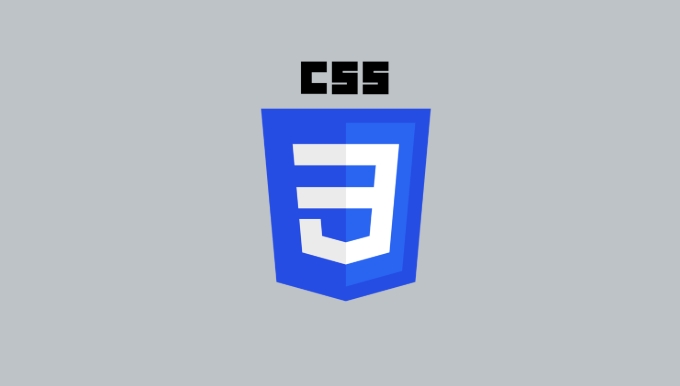 <p> Using CSS pseudo-elements (
<p> Using CSS pseudo-elements ( ::before and ::after ) allows us to insert additional content before and after elements in the page without modifying the HTML structure. This is very practical when doing scenes such as decorative content, icons, prompt information, etc.

Basic usage: Add simple text or style
<p> The most basic purpose is to insert text or symbols throughcontent attribute. for example:

p::before {
content: "Note:";
color: red;
}<p> This will prepend each <p> tag with the red "Note:". It should be noted that if content is not set or the value is an empty value other than the empty string, the pseudo-element will not be displayed .<p> Common tips include: 
- Insert quotation marks, arrows, icon fonts
- Add a decorative line or background decoration
- Implement UI details such as small triangles and dots
Layout and decoration: Small details that enhance visual effects
<p> Pseudo-elements are not only used to add text, but can also be used in conjunction with positioning and style to achieve some small visual decoration. For example, the common "prompt box with arrows" can be used to draw small triangles using::after : .tooltip::after {
content: "";
position: absolute;
bottom: -10px;
left: 50%;
transform: translateX(-50%);
border-width: 10px 10px 0;
border-style: solid;
border-color: #333 transparent transparent transparent;
}<p> The advantage of this practice is that it does not require additional labels and is clean in structure. Similar things include button hover effect, gradient border, shadow enhancement, etc., which can all be achieved with the help of pseudo-elements.Clear floating or other auxiliary functions
<p> Although Flexbox and Grid are now widely used, in some old projects::after is also commonly used to clear floats. for example: .clearfix::after {
content: "";
display: table;
clear: both;
}<p> This method can solve the floating collapse problem without removing HTML elements. While modern layouts have reduced this need, knowing it can still help maintain old code.
Notes and FAQs
<p> Pay attention to the following points when using pseudo-elements to avoid getting stuck:-
contentmust be available, even if it is just an empty string"" - The pseudo-element is
inlineby default, anddisplayneeds to be adjusted according to the situation. - You can set width, height, positioning, animation and other styles, but they cannot be retrieved or operated by JS.
- Not suitable for important content because they are not in the DOM and are not accessible and SEO friendly
The above is the detailed content of Employing CSS pseudo-elements (`::before`, `::after`). For more information, please follow other related articles on the PHP Chinese website!

Hot AI Tools

Undress AI Tool
Undress images for free

Undresser.AI Undress
AI-powered app for creating realistic nude photos

AI Clothes Remover
Online AI tool for removing clothes from photos.

Clothoff.io
AI clothes remover

Video Face Swap
Swap faces in any video effortlessly with our completely free AI face swap tool!

Hot Article

Hot Tools

Notepad++7.3.1
Easy-to-use and free code editor

SublimeText3 Chinese version
Chinese version, very easy to use

Zend Studio 13.0.1
Powerful PHP integrated development environment

Dreamweaver CS6
Visual web development tools

SublimeText3 Mac version
God-level code editing software (SublimeText3)

Hot Topics
 How can I include CSS only on some pages?
Jun 11, 2025 am 12:01 AM
How can I include CSS only on some pages?
Jun 11, 2025 am 12:01 AM
There are three ways to selectively include CSS on a specific page: 1. Inline CSS, suitable for pages that are not frequently accessed or require unique styles; 2. Load external CSS files using JavaScript conditions, suitable for situations where flexibility is required; 3. Containment on the server side, suitable for scenarios using server-side languages. This approach can optimize website performance and maintainability, but requires balance of modularity and performance.
 Flexbox vs Grid: Understanding the Key Differences in CSS Layout
Jun 10, 2025 am 12:03 AM
Flexbox vs Grid: Understanding the Key Differences in CSS Layout
Jun 10, 2025 am 12:03 AM
Flexboxisidealforone-dimensionallayouts,whileGridsuitstwo-dimensional,complexlayouts.UseFlexboxforaligningitemsinasingleaxisandGridforprecisecontroloverrowsandcolumnsinintricatedesigns.
 Creating an Auto-Closing Notification With an HTML Popover
Jun 10, 2025 am 09:45 AM
Creating an Auto-Closing Notification With an HTML Popover
Jun 10, 2025 am 09:45 AM
The HTML popover attribute transforms elements into top-layer elements that can be opened and closed with a button or JavaScript. Popovers can be dismissed a number of ways, but there is no option to auto-close them. Preethi has a technique you can u
 What is 'render-blocking CSS'?
Jun 24, 2025 am 12:42 AM
What is 'render-blocking CSS'?
Jun 24, 2025 am 12:42 AM
CSS blocks page rendering because browsers view inline and external CSS as key resources by default, especially with imported stylesheets, header large amounts of inline CSS, and unoptimized media query styles. 1. Extract critical CSS and embed it into HTML; 2. Delay loading non-critical CSS through JavaScript; 3. Use media attributes to optimize loading such as print styles; 4. Compress and merge CSS to reduce requests. It is recommended to use tools to extract key CSS, combine rel="preload" asynchronous loading, and use media delayed loading reasonably to avoid excessive splitting and complex script control.
 How to use Lotties in Figma
Jun 14, 2025 am 10:17 AM
How to use Lotties in Figma
Jun 14, 2025 am 10:17 AM
In the following tutorial, I will show you how to create Lottie animations in Figma. We'll use two colorful designs to exmplify how you can animate in Figma, and then I'll show you how to go from Figma to Lottie animations. All you need is a free Fig
 Breaking Boundaries: Building a Tangram Puzzle With (S)CSS
Jun 13, 2025 am 11:33 AM
Breaking Boundaries: Building a Tangram Puzzle With (S)CSS
Jun 13, 2025 am 11:33 AM
We put it to the test and it turns out Sass can replace JavaScript, at least when it comes to low-level logic and puzzle behavior. With nothing but maps, mixins, functions, and a whole lot of math, we managed to bring our Tangram puzzle to life, no J
 External vs. Internal CSS: What's the Best Approach?
Jun 20, 2025 am 12:45 AM
External vs. Internal CSS: What's the Best Approach?
Jun 20, 2025 am 12:45 AM
ThebestapproachforCSSdependsontheproject'sspecificneeds.Forlargerprojects,externalCSSisbetterduetomaintainabilityandreusability;forsmallerprojectsorsingle-pageapplications,internalCSSmightbemoresuitable.It'scrucialtobalanceprojectsize,performanceneed
 Does my CSS must be on lower case?
Jun 19, 2025 am 12:29 AM
Does my CSS must be on lower case?
Jun 19, 2025 am 12:29 AM
No,CSSdoesnothavetobeinlowercase.However,usinglowercaseisrecommendedfor:1)Consistencyandreadability,2)Avoidingerrorsinrelatedtechnologies,3)Potentialperformancebenefits,and4)Improvedcollaborationwithinteams.






